Art that Disarms and Subverts the Narrative of Protesters as Vandals and Terrorists
From the Series: The "Marcha a Lima" against the Denial of Modern Political Rights
From the Series: The "Marcha a Lima" against the Denial of Modern Political Rights
Behind the banner “Red Nacional de Trabajadores de las Artes y la Cultura,” United Artists Against the Dictatorship have joined the massive protests in Lima since January 2023. They march as “artists with political consciousness” who transfer and express creatively through art their “outrage and pain” for the antidemocratic actions of Dina Boluarte’s government.
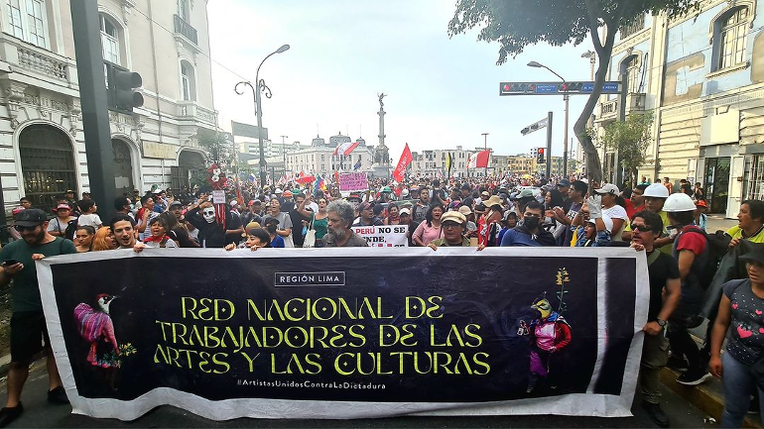
Protests nationwide continue after a holiday season truce. The dead had increased to 53 after the massacre in Puno on January 9. Thousands meet for a first mass protest at Plaza Dos de Mayo to march towards the National Congress building, incensed at the government’s disproportionate use of violence against compatriots in the Andean South. Protesters raise slogans in unison to condemn the government. “¡Dina asesina! (Dina is a murderer!)” sounds like a roar as protesters carry carboard coffins, photos of the victims, and banners with anti-government slogans. But among the many visually striking images, one in particular catches my eye, a retablo[1] made of cardboard, inspired in the portable Andean altar from Ayacucho, where the massacre perpetrated by the army had resulted in the death of ten citizens on December 15, 2022 (Figure 2).
This type of altar, well-known nationwide, becomes a shrine for all the dead with their names or initials, their photos and “NN” for those still unidentified. The white of traditional retablos is combined with red to remind viewers of the bloodbath, and black to evoke the community’s grief. Aesthetically, the retablo
seems at odds with the conventional use of posters with photographs of victims carried in protests. It holds, however, a visual and affective familiarity with religious cultural practices that invites protesters to make the sign of the cross and take turns carrying the altar as if in a pilgrimage or procession. One retablo, “carried” by many, regardless of gender, cultural background, or social class, to create a grieving collective that is political (Harris 2022).
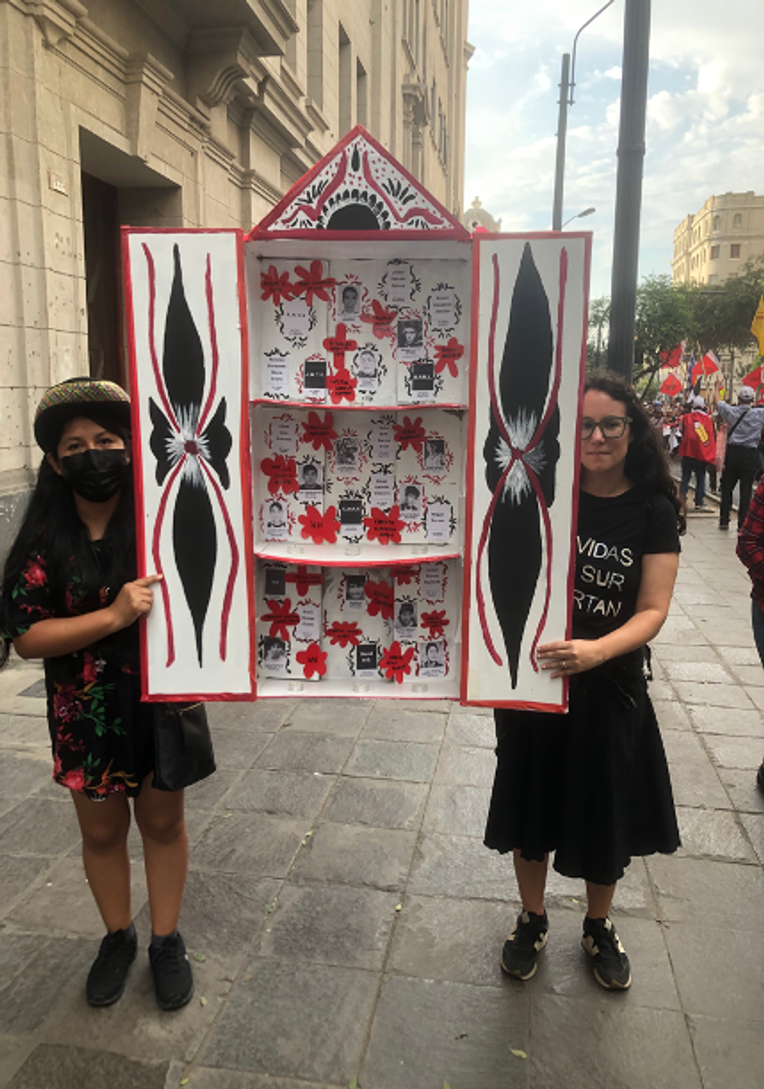
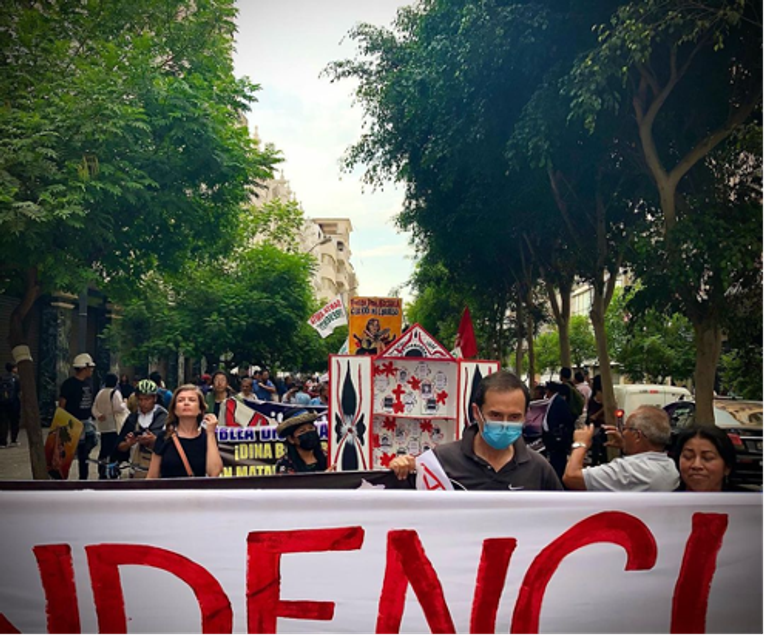
An unprecedent deployment of over 11,000 policemen didn’t dissuade thousands of protesters, many of whom had arrived from Peru’s Indigenous south, to takeover Lima. This time, ten retablos in poster format join the march; some honoring the dead with their photos and names, others with slogans that confront the government with their deadly repression, “53 murdered, 44 days in government,” “Lives in the Andes Matter,” “¡No more deaths!”
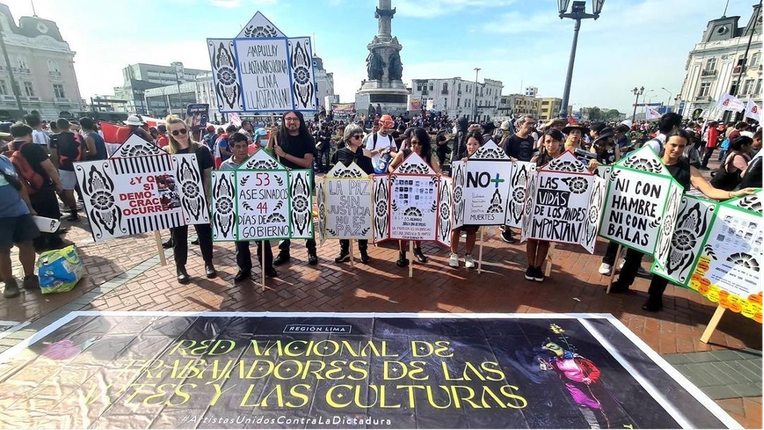
Six modern-style umbrellas with images and names of the victims, also “leave a trace” of the dead on the streets. Like the retablos they exhort the government to stop the killings. The umbrellas remind me of the 2014 Hong Kong pro-democracy protests, where umbrellas shielded protesters from tear gas. In la Toma de Lima, the umbrellas are used for a different purpose, despite the indiscriminate use of tear gas. They protect the carriers from the blazing sun and hide their identities when confronted with “recognizable” infiltrated police.
They also offer symbolic protection; each image of a victim embroidered into an umbrella, is conceived as a deténte, a type of religious scapulary that protects the person who wears it. Its symbolism also evokes the deténte bala (stop bullet) scapulary worn by soldiers from opposite sides during Peru’s wars of independence. In the present context, however, the deténte is resignified to seek protection from the violent iron fist of Dina “Balearte” (Dina “will shoot you”), the nickname of the infamous first woman president of Peru. The act of sewing also suggests the need to repair the social fabric.
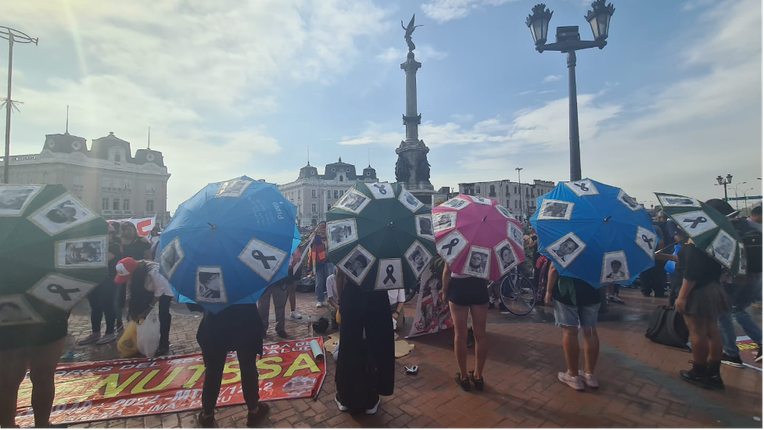

Retablos and umbrellas make visible the victims’ Andean background and the element of racism in the state’s violence. A shared pro-democracy sentiment also links local and global experiences.
It is the first day of the nationwide strike called by the General Confederation of Workers to demand the resignation of Dina Boluarte. It is also the one-month anniversary of the 19 Peruvians killed in Juliaca, Puno. One hundred retablos pancartas (poster retablos) to remember the dead, which has risen to more than sixty, arrive to the Plaza Dos de Mayo. Victims are embodied in their own retablo and accompanied by others with a variety of slogans, some denouncing a regime experienced as a “dictatorship disguised as democracy,” racist and discriminatory; others reaffirming their Indigenous and rural identities.
Placed on the ground before joining the march, the colorful retablos grab the attention of protesters at the plaza, who after some initial reticence willingly engage with the art intervention to write their own claims on the backside of the retablos, and incorporate some of them into their own civil-social organizations and groups. The sprinkled retablos could be seen as representative of encounters and dialogues among people from different regions of Peru whether urban or rural, or among different racial and social backgrounds, and even among different claims and political stances. Undoubtedly, what united us all was our grief for the dead and the swelling anger over impunity.

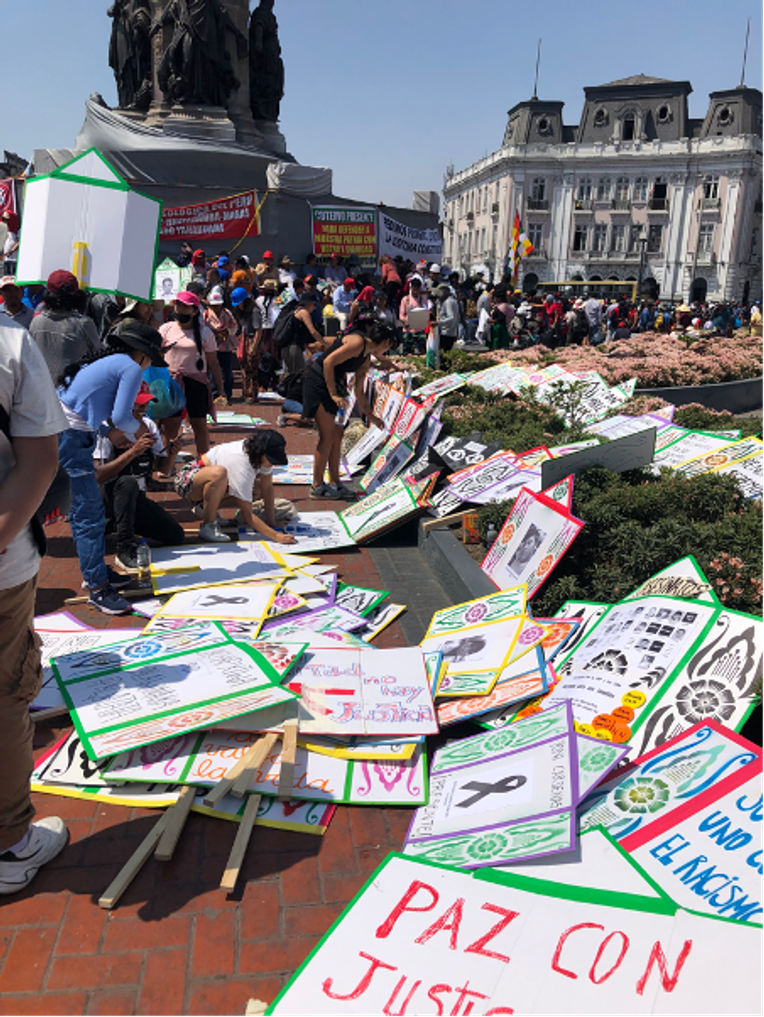

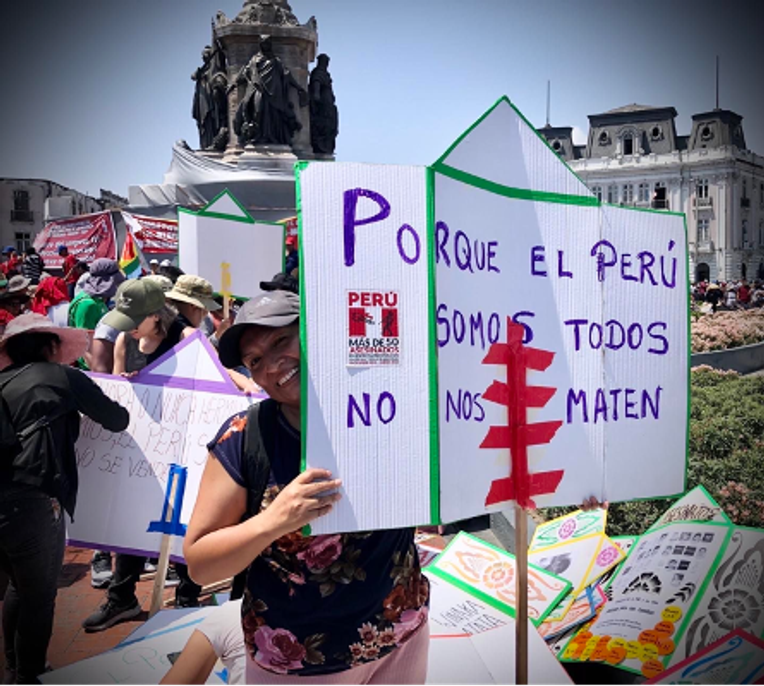

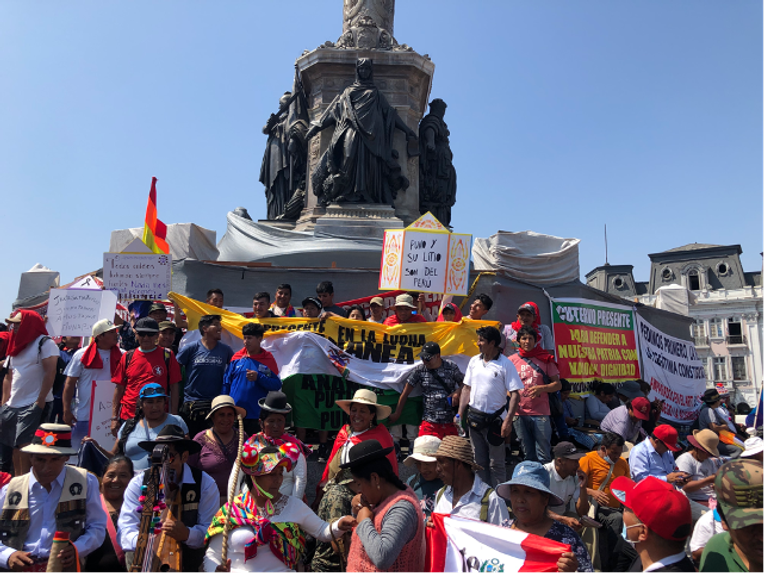
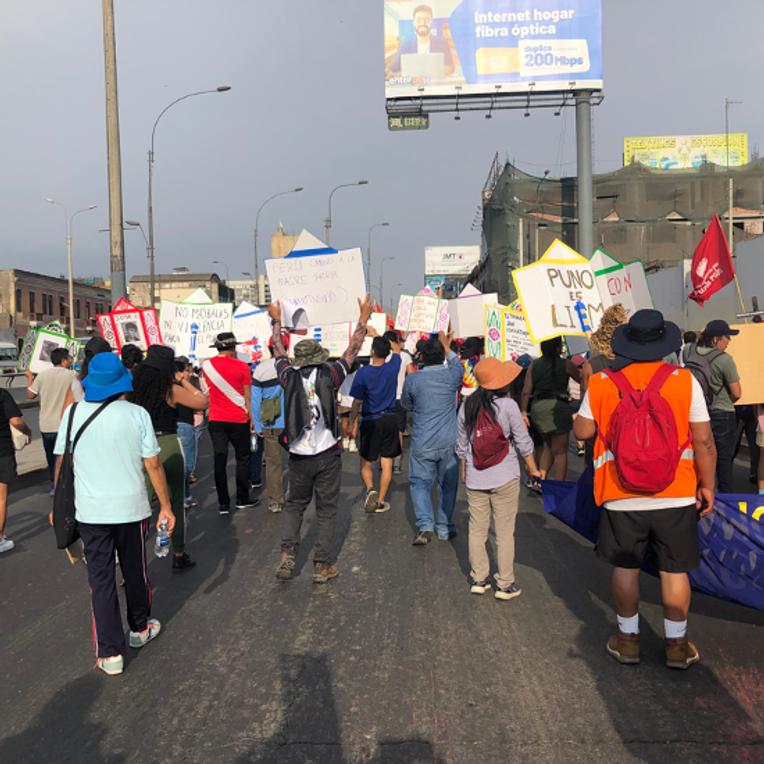
The anti-memorial, performed in the style of guerrilla art, gave further presence to the dead in unexpected ways and public spaces. In a few minutes the anti-memorial is completed and the disguised artists blend into the crowd. It offered a transitory place to put their grief. Some passersby stop to lay their hand on a photo and make a sign of the cross in this ephemeral pantheon.
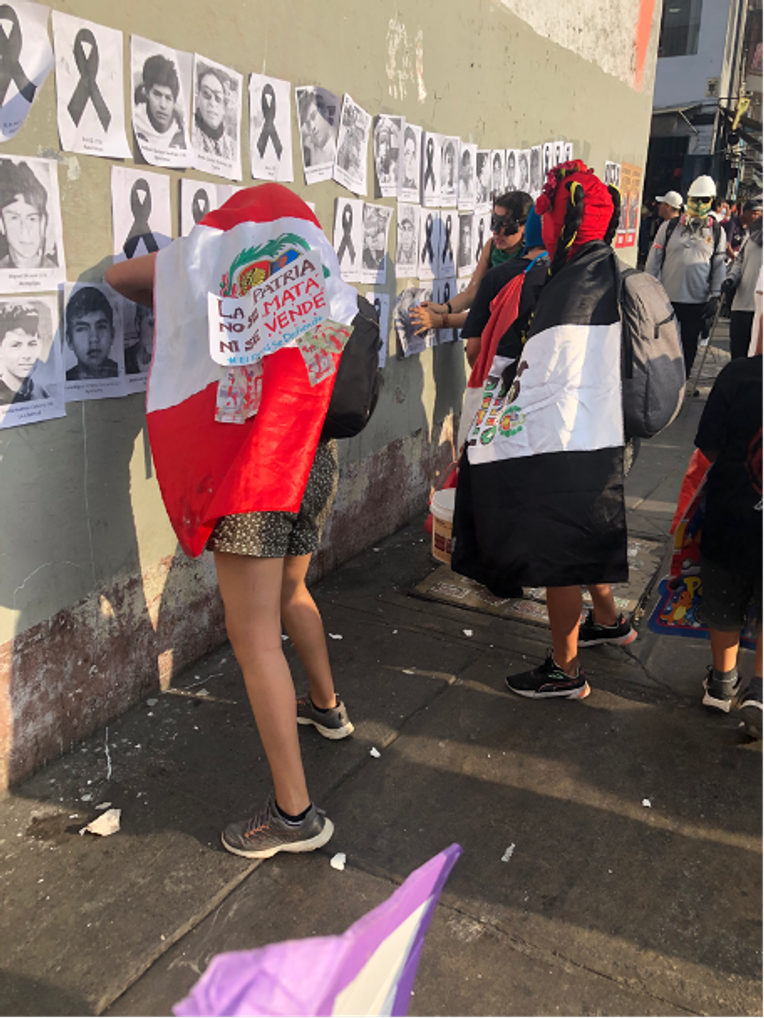
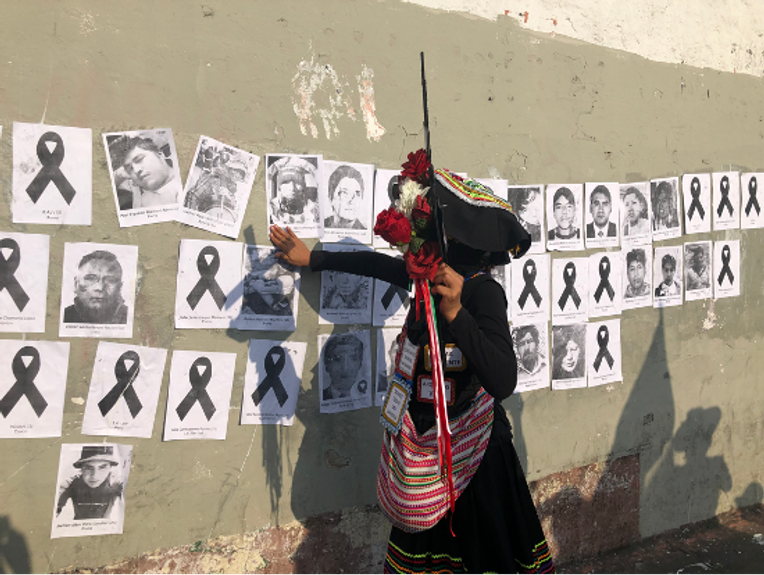
The retablos, umbrellas, and anti-memorials are just a few examples of art that responds to a poetics of grief (Vich 2015) that questions citizens about who is considered killable and ungrievable in Peru (González 2015). This artwork has the power to disarm in the name of solidarity, subverting the narrative about protesters being violent vandals and terrucos, a colloquial term used as a substitute for terrorist by conservative elites and the Peruvian right. Rather than the “enemy other” that terruqueo affirms to delegitimize and stigmatize social movements (Velásquez Villalba 2022), artists open up a complexly inclusive subject-position for all protesters: one that affirms an “us” without canceling differences.
[1] See Ulfe 2004 for information about how the retablo, originally a religious object, became art to express a variety of topics, including those related to social and political issues.
González, Olga. 2015. “Visualización de una política de duelo excluyente: iniciativas artísticas por los desaparecidos en el Perú” [Visualization of Ungrievable Lives: Artistic initiatives for the disappeared in Peru]. In Poíiticas en justicia transicional: Miradas comparativas sobre el legado de la CVR, edited by Ponciano del Pino and Ludwig Huber. Lima: Instituto de Estudios Peruanos.
Harris, Darcy. 2022. “Political Grief.” Illness, Crisis & Loss 30, no. 3: 572–589.
Ulfe, María Eugenia. 2004. “El arte de los retablos ayacuchanos: Religiosidad, historia y práctica cultural emergente” [The Art of the Ayacucho retablos: Religiosity, History and Emerging Cultural Practice]. Allpanchis 36, no. 64: 73–99.
Velásquez Villalba, Fernando. 2022. “De las batallas por la memoria a la marca del conflicto: ‘Terruqueo,’ estigmatización y violencia en el Perú reciente” [From the battles for memory to the branding of the conflict: “Terruqueo,” stigmatization and violence in recent Peru]. Revista electrónica de estudios latinoamericanos 20, no. 80.
Vich, Victor. 2015. Poéticas del duelo: Ensayos sobre arte, memoria y violencia política en el Perú [Poetics of grief: Essays on art, memory and political violence in Peru]. Lima: Instituto de Estudios Peruanos.